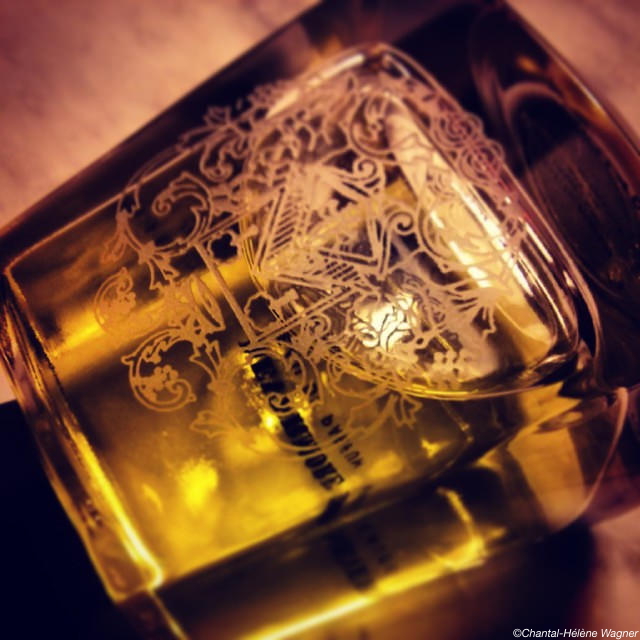Frapin Nevermore (2014) {Perfume Review & Musings}

Nevermore by Frapin, the newest cognac house fragrance composition signed by perfumer Anne-Sophie Berhaghel, opens on a very nuanced and dark rose accord which seems to fleet through rapidly succeeding stages of woodiness, from medicinal oud going through wet woods, to a forest accord, and then an inky, black moment in which you were ushered in thanks to oud and comes out from thanks to cognac. At the end of this incursion, the perfume calms down to a rounder, mellower and softer cognac sensation lingering solo on the skin...
The house of Frapin started out in perfumery with fragrances that were inspired by their main activities as cognac makers; see also L'Humaniste. This time, they go for a different approach, leaving their domain of Segonzac in the South West of France to venture into a living literary American myth where a bottle of Cognac plays a central role, the one bestowed anonymosuly upon the tomb of writer and poet Edgar Alla Poe in Baltimore, Maryland by the so-called Poe Toaster, a yearly offering on the 19th of January, day of the birth of the poet, and accompanied with red roses. Apparently, the tradition ended in 2010.
If the composition started out by feeling dramatic evoking a Gothic-novel atmosphere of shadowy, torn, silhouetted black landscapes, it settles into a second mood rapidly where all sounds and sensations are muffled and even unnervingly quiet.
If you were smelling this sillage on a man, you would think that he is a quiet drunk, even meditative - perhaps is he holding a glass in his hands with his gaze turned inwards towards long-forgotten memories.
Knowing the background story to the scent, you of course are free to imagine that you are partaking for a time of the stillness of death. Not a wind rustles through the leaves of the trees in this cemetery. The perfume has become quasi immobile.
In terms of perfumery construction, it is surprising to experience such a brusque turn of road from a forlorn, difficult landscape to a much quieter and stiller atmosphere.
The Cognac accord is very much in the center of things rather than as an underscore of the rose accord. In fact, the rose retreats a bit behind the bottle of Cognac.
The composition, in a third distinctive stage, becomes a subtle skin scent with the perfume melting into your skin. It becomes whispery but also softly glowing, enough so that it projects some quiet radiance around yourself.
Nevermore eau de parfum was baptized after the leitmotiv of metaphysical depth found in the poem by Edgar Allan Poe, The Raven. It partly manages to capture some of the atmosphere of the verses albeit never smelling quite as feverish and despairing as the text itself. Some aspects which are recurring in this ode to the dead, radiant maiden Lenore could have been more explored olfactorily, like the motif of the purple colour which repeats itself.
The whole poem is suffused with quiet despair exploring how far you can rhythmically reiterate that no hope exists in this world or the hereafter to the point where it leaves a lasting impression in you that this constitutes the ultimate truth. There is no escape, only drugs, like the drink of no-sorrow, "nepenthe" which will temporarily heal your soul from the blinding truth uttered by the mournful, unmovable, croaking raven, a symbol of death.
The Raven has only one passage where there is an explicit olfactory reference, to incense.
Then, methought, the air grew denser, perfumed from an unseen censer
Swung by seraphim whose foot-falls tinkled on the tufted floor.
"Wretch," I cried, "thy God hath lent thee--by these angels he hath sent thee
Respite--respite and nepenthe from thy memories of Lenore!"
Quaff, oh quaff this kind nepenthe, and forget this lost Lenore."
Quoth the Raven, "Nevermore."
The eau de parfum is not very characteristically incensey. It is there, but it is a subtle presence.
To be noted also is that the longer drydown smells of the aldehydes of Chanel No.5.
It seems that what has been retained for the composition to be illustrative of the poem are a short incursion into horror while mostly settling into a mood of quiet, metaphysical drunkenness sweetened by roses. There is a certain level of self-undulgence in this poem by Poe. He finds a sort of soft voluptuousness in reiterating that death and furthermore oblivion are inevitable. You could see it almost as pretext for indulging in the pleasure of drinking.
While the house stresses that the perfume offers "violent", "bitter", "metallic" and "ice-cold" facets, I find that it is rather an easy perfume to wear. The only moment when I have a retreating attitude towards it is when it smells a bit too much of Cognac, which can trigger a gag reflex in me. You are experiencing the quiet, softness of despair and soothing effect of nepenthe rather than the more intolerable sides of metaphysical angst which led to overdrinking.
If you are looking for a rose perfume which is dark yet soft and with a boozy cast, this is one to try. This description differs from that of the house which labels the perfume as a "spicy, woody, metallic rose". To me, it makes me think most in the end of the sensation you get sometimes from drinking a wine which is so light and easy on the taste buds that it seems you are drinking water. Perfume-wise, it is this equivalent: dark, ruby-like, a bit smoky, yet as light and fluid as water.
Fragrance notes: black pepper, nutmeg, Floralozone, aldehydes / rose oxide, May rose, Damascena rose, red wine / safran, Atlas cedar, ambery woods.
You can read or re-read the whole poem here.
Funeral picture of Edgar Allan Poe here









